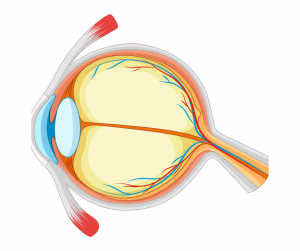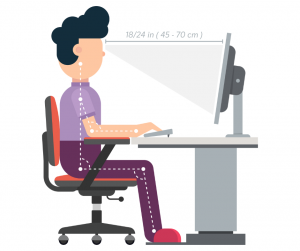Your Eye Health
by Dr. David LaRue, D.O.  The eye is a complex instrument with many parts, and in the urgent care setting, we have to know the intricacies of them all. But in short, the front part — lens and cornea — capture images and bend light energy (so-called photons) onto the back wall — the retina. Amazingly, the retina has 120 million rods and 6 million cones — these photoreceptors convert light into electrochemical signals that pass to the brain via the optic nerve (1/3 of our cerebral cortex is dedicated to vision!)
A plethora of eye conditions present to our urgent care, but the most common is a red, irritated eye. Patients often complain that they have “pink eye.” This is certainly common, but a dizzying array of possibilities exist…blepharitis, conjunctivitis, styes, sicca, keratitis, scleritis, and the tongue twister…endophthalmitis! My fan favorite is keratitis or cornea inflammatory afflictions.
The cornea deserves a shout-out. This modest, clear, dome-shaped goggle protects our eyes from environmental insults and provides 2/3 of the eyeballs focusing power. The lens, which gets all the credit, does only 1/3. Seemingly so simple, you’d mistake it for your contact lens if you were to place it on your finger…but it’s a wonder of complexity. Five tissue layers of epithelium, Bowman’s membrane, Descemet’s membrane, etc. All encapsulated into a 1/2 millimeter thin space. Cornea scratches, foreign bodies, and infections also present with a red, irritated eye — and are often very painful.
We are well equipped to diagnose and treat most eye cases. We are trained to use a high-grade instrument called a slit lamp allowing 40 times magnification of the eye anatomy. Therefore, we can SEE much more than the proverbial “naked eye.” So if you have eye symptoms, don’t hesitate, come on in. We look forward to SEEING you:)
The eye is a complex instrument with many parts, and in the urgent care setting, we have to know the intricacies of them all. But in short, the front part — lens and cornea — capture images and bend light energy (so-called photons) onto the back wall — the retina. Amazingly, the retina has 120 million rods and 6 million cones — these photoreceptors convert light into electrochemical signals that pass to the brain via the optic nerve (1/3 of our cerebral cortex is dedicated to vision!)
A plethora of eye conditions present to our urgent care, but the most common is a red, irritated eye. Patients often complain that they have “pink eye.” This is certainly common, but a dizzying array of possibilities exist…blepharitis, conjunctivitis, styes, sicca, keratitis, scleritis, and the tongue twister…endophthalmitis! My fan favorite is keratitis or cornea inflammatory afflictions.
The cornea deserves a shout-out. This modest, clear, dome-shaped goggle protects our eyes from environmental insults and provides 2/3 of the eyeballs focusing power. The lens, which gets all the credit, does only 1/3. Seemingly so simple, you’d mistake it for your contact lens if you were to place it on your finger…but it’s a wonder of complexity. Five tissue layers of epithelium, Bowman’s membrane, Descemet’s membrane, etc. All encapsulated into a 1/2 millimeter thin space. Cornea scratches, foreign bodies, and infections also present with a red, irritated eye — and are often very painful.
We are well equipped to diagnose and treat most eye cases. We are trained to use a high-grade instrument called a slit lamp allowing 40 times magnification of the eye anatomy. Therefore, we can SEE much more than the proverbial “naked eye.” So if you have eye symptoms, don’t hesitate, come on in. We look forward to SEEING you:)
Workstation Ergonomics By Doreen Hall, PT The COVID 19 pandemic has changed the way we work, maybe for the long run! Across the nation people are working from the “comfort” of home, students are learning remotely, and physical therapists are seeing more and more patients who are suffering pain because of poorly set up workstations. Unfortunately, most of us do not have an ergonomically sound space to spend many hours a day working. Over the years, the laptop computer, designed to be used in the lap, turned into a household staple and the desktop computer is more rarely found in the home anymore. This has impacted how people work and their postures very negatively. If you are working from a laptop it is essential that you use an external keyboard and mouse so that you can raise your monitor, or in this case laptop computer, to a height that you can see while maintaining neutral postures as demonstrated below.
When the work from home emergency started, we had millions of employees and students spending many hours in poor postures and suffering back and neck pain because of it. At SDSM Physical Therapy we are treating many patients, both young and old for repercussions of poor ergonomics at their home workstations.
One of the misconceptions about posture is that we are supposed to be staying in this static upright posture all the time. This is far from the optimal situation! Our bodies are meant to be moving, and therefore if we have a sedentary job we must make time to change positions often, even if it is a small adjustment. choose several different ergonomically sound positions and rotate through them throughout the day.
The COVID 19 pandemic has changed the way we work, maybe for the long run! Across the nation people are working from the “comfort” of home, students are learning remotely, and physical therapists are seeing more and more patients who are suffering pain because of poorly set up workstations. Unfortunately, most of us do not have an ergonomically sound space to spend many hours a day working. Over the years, the laptop computer, designed to be used in the lap, turned into a household staple and the desktop computer is more rarely found in the home anymore. This has impacted how people work and their postures very negatively. If you are working from a laptop it is essential that you use an external keyboard and mouse so that you can raise your monitor, or in this case laptop computer, to a height that you can see while maintaining neutral postures as demonstrated below.
When the work from home emergency started, we had millions of employees and students spending many hours in poor postures and suffering back and neck pain because of it. At SDSM Physical Therapy we are treating many patients, both young and old for repercussions of poor ergonomics at their home workstations.
One of the misconceptions about posture is that we are supposed to be staying in this static upright posture all the time. This is far from the optimal situation! Our bodies are meant to be moving, and therefore if we have a sedentary job we must make time to change positions often, even if it is a small adjustment. choose several different ergonomically sound positions and rotate through them throughout the day.
Understanding Dietary Fat By Linda Illingworth, RDN Dietary fat is one of the most misunderstood macronutrients. For example, you’ve probably seen conflicting advice about saturated fat as healthy, referred to as poison, and everything in between. In truth, we need fat in our diets for energy, as metabolic messengers, and as structural components of our bodies.
Fats are broken into three main categories according to their biochemical structure:
Dietary fat is one of the most misunderstood macronutrients. For example, you’ve probably seen conflicting advice about saturated fat as healthy, referred to as poison, and everything in between. In truth, we need fat in our diets for energy, as metabolic messengers, and as structural components of our bodies.
Fats are broken into three main categories according to their biochemical structure:
 The eye is a complex instrument with many parts, and in the urgent care setting, we have to know the intricacies of them all. But in short, the front part — lens and cornea — capture images and bend light energy (so-called photons) onto the back wall — the retina. Amazingly, the retina has 120 million rods and 6 million cones — these photoreceptors convert light into electrochemical signals that pass to the brain via the optic nerve (1/3 of our cerebral cortex is dedicated to vision!)
A plethora of eye conditions present to our urgent care, but the most common is a red, irritated eye. Patients often complain that they have “pink eye.” This is certainly common, but a dizzying array of possibilities exist…blepharitis, conjunctivitis, styes, sicca, keratitis, scleritis, and the tongue twister…endophthalmitis! My fan favorite is keratitis or cornea inflammatory afflictions.
The cornea deserves a shout-out. This modest, clear, dome-shaped goggle protects our eyes from environmental insults and provides 2/3 of the eyeballs focusing power. The lens, which gets all the credit, does only 1/3. Seemingly so simple, you’d mistake it for your contact lens if you were to place it on your finger…but it’s a wonder of complexity. Five tissue layers of epithelium, Bowman’s membrane, Descemet’s membrane, etc. All encapsulated into a 1/2 millimeter thin space. Cornea scratches, foreign bodies, and infections also present with a red, irritated eye — and are often very painful.
We are well equipped to diagnose and treat most eye cases. We are trained to use a high-grade instrument called a slit lamp allowing 40 times magnification of the eye anatomy. Therefore, we can SEE much more than the proverbial “naked eye.” So if you have eye symptoms, don’t hesitate, come on in. We look forward to SEEING you:)
The eye is a complex instrument with many parts, and in the urgent care setting, we have to know the intricacies of them all. But in short, the front part — lens and cornea — capture images and bend light energy (so-called photons) onto the back wall — the retina. Amazingly, the retina has 120 million rods and 6 million cones — these photoreceptors convert light into electrochemical signals that pass to the brain via the optic nerve (1/3 of our cerebral cortex is dedicated to vision!)
A plethora of eye conditions present to our urgent care, but the most common is a red, irritated eye. Patients often complain that they have “pink eye.” This is certainly common, but a dizzying array of possibilities exist…blepharitis, conjunctivitis, styes, sicca, keratitis, scleritis, and the tongue twister…endophthalmitis! My fan favorite is keratitis or cornea inflammatory afflictions.
The cornea deserves a shout-out. This modest, clear, dome-shaped goggle protects our eyes from environmental insults and provides 2/3 of the eyeballs focusing power. The lens, which gets all the credit, does only 1/3. Seemingly so simple, you’d mistake it for your contact lens if you were to place it on your finger…but it’s a wonder of complexity. Five tissue layers of epithelium, Bowman’s membrane, Descemet’s membrane, etc. All encapsulated into a 1/2 millimeter thin space. Cornea scratches, foreign bodies, and infections also present with a red, irritated eye — and are often very painful.
We are well equipped to diagnose and treat most eye cases. We are trained to use a high-grade instrument called a slit lamp allowing 40 times magnification of the eye anatomy. Therefore, we can SEE much more than the proverbial “naked eye.” So if you have eye symptoms, don’t hesitate, come on in. We look forward to SEEING you:)
Workstation Ergonomics By Doreen Hall, PT
 The COVID 19 pandemic has changed the way we work, maybe for the long run! Across the nation people are working from the “comfort” of home, students are learning remotely, and physical therapists are seeing more and more patients who are suffering pain because of poorly set up workstations. Unfortunately, most of us do not have an ergonomically sound space to spend many hours a day working. Over the years, the laptop computer, designed to be used in the lap, turned into a household staple and the desktop computer is more rarely found in the home anymore. This has impacted how people work and their postures very negatively. If you are working from a laptop it is essential that you use an external keyboard and mouse so that you can raise your monitor, or in this case laptop computer, to a height that you can see while maintaining neutral postures as demonstrated below.
When the work from home emergency started, we had millions of employees and students spending many hours in poor postures and suffering back and neck pain because of it. At SDSM Physical Therapy we are treating many patients, both young and old for repercussions of poor ergonomics at their home workstations.
One of the misconceptions about posture is that we are supposed to be staying in this static upright posture all the time. This is far from the optimal situation! Our bodies are meant to be moving, and therefore if we have a sedentary job we must make time to change positions often, even if it is a small adjustment. choose several different ergonomically sound positions and rotate through them throughout the day.
The COVID 19 pandemic has changed the way we work, maybe for the long run! Across the nation people are working from the “comfort” of home, students are learning remotely, and physical therapists are seeing more and more patients who are suffering pain because of poorly set up workstations. Unfortunately, most of us do not have an ergonomically sound space to spend many hours a day working. Over the years, the laptop computer, designed to be used in the lap, turned into a household staple and the desktop computer is more rarely found in the home anymore. This has impacted how people work and their postures very negatively. If you are working from a laptop it is essential that you use an external keyboard and mouse so that you can raise your monitor, or in this case laptop computer, to a height that you can see while maintaining neutral postures as demonstrated below.
When the work from home emergency started, we had millions of employees and students spending many hours in poor postures and suffering back and neck pain because of it. At SDSM Physical Therapy we are treating many patients, both young and old for repercussions of poor ergonomics at their home workstations.
One of the misconceptions about posture is that we are supposed to be staying in this static upright posture all the time. This is far from the optimal situation! Our bodies are meant to be moving, and therefore if we have a sedentary job we must make time to change positions often, even if it is a small adjustment. choose several different ergonomically sound positions and rotate through them throughout the day. - Top of the monitor at or just below eye level
- Head and neck balanced and in-line with the torso
- Shoulders relaxed
- Elbows close to the body and well supported
- Lower back supported
- Wrists and hands in line with forearms
- Adequate room for keyboard and mouse
- Feet flat on the floor
- Make small adjustments to your chair or backrest.
- Stretch your fingers, hands, arms, and torso.
- Stand up and walk around for a few minutes periodically.
- Perform some of your tasks in standing: computing, reading, phone, meetings.
Understanding Dietary Fat By Linda Illingworth, RDN
 Dietary fat is one of the most misunderstood macronutrients. For example, you’ve probably seen conflicting advice about saturated fat as healthy, referred to as poison, and everything in between. In truth, we need fat in our diets for energy, as metabolic messengers, and as structural components of our bodies.
Fats are broken into three main categories according to their biochemical structure:
Dietary fat is one of the most misunderstood macronutrients. For example, you’ve probably seen conflicting advice about saturated fat as healthy, referred to as poison, and everything in between. In truth, we need fat in our diets for energy, as metabolic messengers, and as structural components of our bodies.
Fats are broken into three main categories according to their biochemical structure:- Saturated fat (no double bonds)
- Polyunsaturated fat (multiple double bonds)
- Monounsaturated fat (one double bond)
- Margarine and vegetable shortening
- Sunflower and safflower oils
- Corn oil, cottonseed oil, and mixed vegetable oils.
- Products made with refined soybean oil
- All products made with any partially hydrogenated oils
- LIMIT coconut oil intake, it is still saturated fat and can have the same damaging effects
- Olive oil on salads, for low heat cooking, to top-dress vegetables
- Avocado oil for high heat cooking, baking, and anywhere you want a neutral-tasting oil
- Walnut oil, for salads, in smoothies, or drizzling on cooked dishes, not for cooking
- Sesame oil, to add flavor
- Nuts and seeds of all sorts (macadamia are higher in saturated fat, consume in moderation)
- Fatty fish like salmon, sardines, anchovy, herring, limit tuna to once a week, avoid shark and swordfish entirely
- Choose egg or bacon, not both, add avocado
- Replace cheese with avocado on sandwiches, or pumpkin seeds in salads
- Replace sour cream with plain yogurt in dips, on baked potatoes or base for salad dressing (use regular, not Greek for a milder flavor)
- Use avocado oil in pancake batters, muffins, and other baked goods
- Use avocado as a base for salad dressing by blending into a bit of olive oil and vinegar
- Reduce butter in a recipe by 1/2 and replace with avocado oil
- Reduce use of fat by using applesauce or ground flaxseed to replace some of the fat in baked goods
- Replace eggs in baked goods with a flax egg

